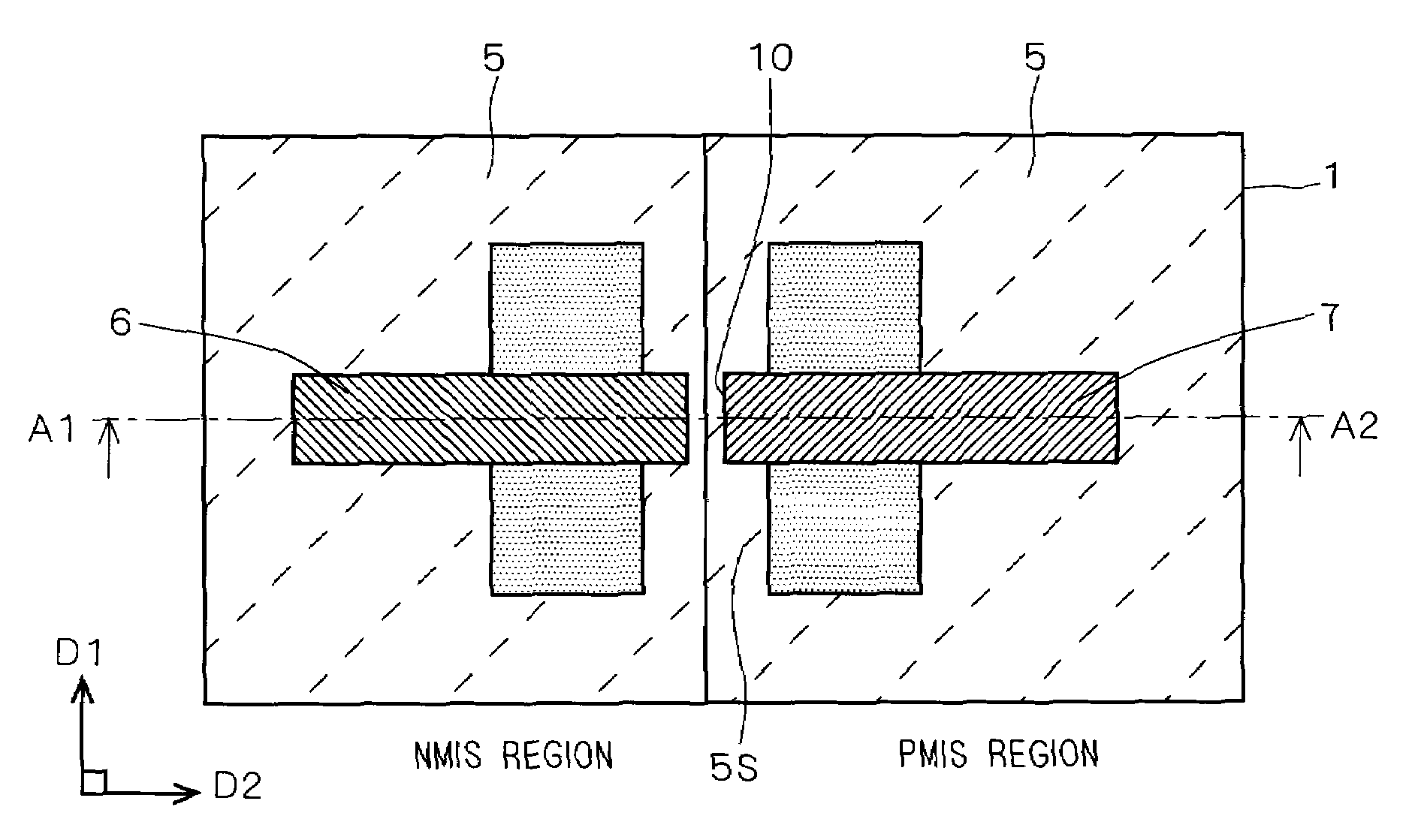Semiconductor device including cmis transistor
a technology of cmis transistor and semiconductor device, which is applied in the direction of transistors, semiconductor devices, electrical appliances, etc., can solve the problems of not being able to achieve normal operation of the semiconductor device, unable to manufacture the cmos device, and unable to achieve expected drain curren
- Summary
- Abstract
- Description
- Claims
- Application Information
AI Technical Summary
Benefits of technology
Problems solved by technology
Method used
Image
Examples
first embodiment
Effect of First Embodiment
[0066]In the present embodiment, the pattern of the gate electrodes is assumed to have an independent shape for the NMIS region and the PMIS region, and the connection between the gates at the PN boundary is realized with the conducive film 20 to be filled into the connection hole 19 formed in the inter-layer insulating film 18. Therefore, according to the present embodiment, the above described configuration is realized by simply changing the mask pattern with respect to the conventional manufacturing step, and the mutual diffusion of the gate materials of the NMIS transistor and the PMIS transistor at the PN region is prevented without involving increase in manufacturing cost, and degradation of the performance of the CMIS transistor is prevented.
Second Embodiment
[0067]The method of forming the metal silicide gate that can prevent mutual diffusion of the metal atoms to the gate of different conductivity-type in the silicide reaction of the gates in the CM...
second embodiment
Effect of Second Embodiment
[0076]Since the metal film having a lower resistance than the metal silicide is used, and different metal materials are used for the gate electrodes in different conductivity-type transistors, the mutual diffusion of metal atoms between the gate electrodes is further prevented.
Third Embodiment
[0077]As the isolation width becomes narrower with miniaturization, setting the interval between the gate electrodes facing each other narrow in accordance with the isolation width becomes difficult in terms of limitation of lithography in the case of forming the aforementioned gap 10 (see FIG. 2) between the gate electrodes of the NMIS transistor and the PMIS transistor. The projecting amount from the active layer of the gate electrode to the isolation insulating film normally requires about 30 nm to 50 nm from the demands of lithography in order to ensure a gate length. The value combining the projection amount from both gate electrodes is 60 nm to 100 nm. As the wi...
third embodiment
Effect of Third Embodiment
[0086]According to the present embodiment, the pattern of the narrow gap 10 can be formed by facing the gate electrodes 24, 25 of both conductivity types at the PN boundary even if the width of the isolation insulating film located at the PN boundary is narrowed by miniaturization, and further miniaturization of the device can be achieved.
Fourth Embodiment
[0087]The conductive film for connecting the both gate electrodes, which is the core of the present embodiment, has a configuration of being embedded and formed in an insulating film surrounding the both gate electrodes and having the upper surface located in the same plane as the upper surfaces of the both gate electrodes, where the upper end of the conductive film and the upper ends of the both gate electrodes are substantially in plane. According to such configuration, a connection hole does not need to be formed in the inter-layer insulating film formed in the CMIS transistor, and layout restriction of...
PUM
 Login to View More
Login to View More Abstract
Description
Claims
Application Information
 Login to View More
Login to View More - R&D
- Intellectual Property
- Life Sciences
- Materials
- Tech Scout
- Unparalleled Data Quality
- Higher Quality Content
- 60% Fewer Hallucinations
Browse by: Latest US Patents, China's latest patents, Technical Efficacy Thesaurus, Application Domain, Technology Topic, Popular Technical Reports.
© 2025 PatSnap. All rights reserved.Legal|Privacy policy|Modern Slavery Act Transparency Statement|Sitemap|About US| Contact US: help@patsnap.com



